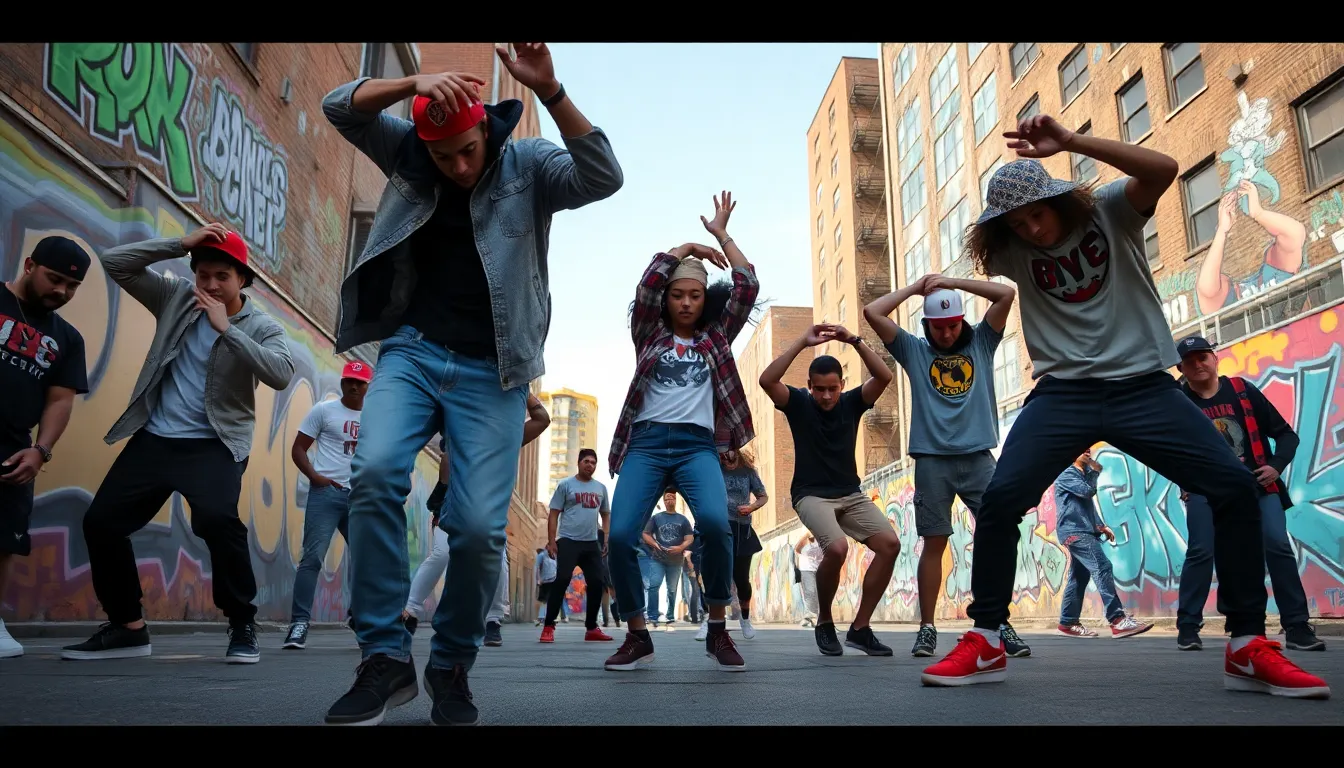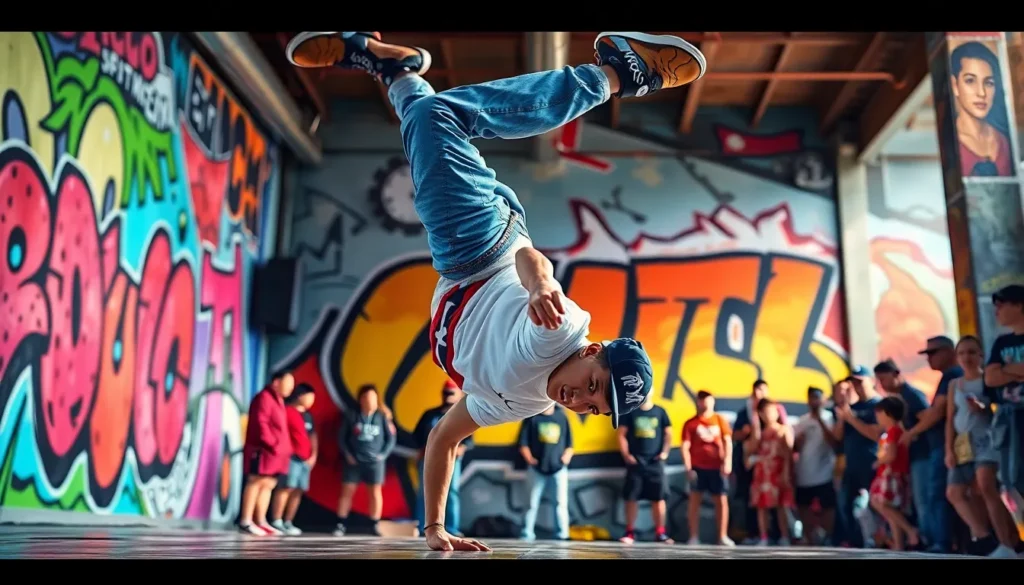Break dancing is about to take center stage in the Olympic arena, and it’s not just a dance-off in the schoolyard anymore. With its inclusion in the 2024 Paris Games, this vibrant art form is set to flip, spin, and pop its way into the hearts of millions. Imagine athletes trading their track shoes for sneakers, showcasing gravity-defying moves that leave audiences gasping and judges scratching their heads.
This isn’t just a dance; it’s a sport that demands strength, agility, and creativity. From the iconic windmill to the dizzying headspin, break dancing combines athleticism with artistry in a way that’s sure to captivate fans worldwide. So, as the countdown to Paris begins, get ready to witness a new kind of Olympic magic that’ll have everyone wanting to bust a move.
Break Dancing Olympic Sport
Break dancing, officially referred to as breaking, gained Olympic recognition as part of the 2024 Paris Games. This decision emphasizes the sport’s rising popularity and cultural significance. Athletes from around the world will compete, showcasing their skills and creativity. The inclusion marks a significant step in broadening the Olympic program to engage younger audiences.
Judges will assess break dancers based on various criteria, including technique, style, and performance. Competitors execute moves like freezes, spins, and intricate footwork, illustrating their physical strength and artistic expression. Each battle, a head-to-head competition, provides an exhilarating atmosphere that captivates spectators.
The International Olympic Committee highlighted breaking’s ability to unite diverse communities, fostering an inclusive environment. This appeal lies in its roots in street culture, which resonates with individuals across different backgrounds. The 2024 Olympics aims to create a vibrant atmosphere by integrating this dynamic sport alongside traditional events.
Preparation for breaking competitors involves extensive training in both physical conditioning and dance techniques. Many dancers dedicate years to mastering their craft, refining their individual styles. As a result, the event is expected to showcase a blend of athletic prowess and creative artistry.
The potential impact of breaking on the Olympic landscape remains significant. Integrating this art form into the Games provides opportunities to redefine traditional sports narratives. Spectators can look forward to witnessing a fresh and exhilarating competition, affirming breaking’s place in the Olympic history.
History of Break Dancing

Break dancing, officially known as breaking, has a rich history that traces its roots back to the late 1960s and early 1970s in the Bronx, New York City. This dance form emerged from the vibrant street culture, blending elements of funk, hip-hop, and various dance styles.
Origins and Evolution
Initially, breaking served as a form of expression for young people in urban communities, reflecting their experiences and aspirations. B-boys and B-girls developed unique styles characterized by acrobatic moves, spins, and freezes. Over the years, breaking evolved from informal street gatherings to organized competitions, gaining popularity and recognition worldwide. Key events such as the first battle at the Bronx’s Cool Herc’s parties established a framework for the dance’s competitive nature.
Break Dancing in Competitive Arenas
Breaking’s transition into competitive arenas showcased the skill, artistry, and creativity of its dancers. Competitions began appearing in the early 1980s, including the renowned Battle of the Year, which brought together talent from different countries. Judges assess dancers on technique, originality, and style, creating an adrenaline-fueled atmosphere. Major events contributed to breaking’s status as a legitimate sport, inspiring future generations to push the boundaries of what is possible on the dance floor.
Inclusion in the Olympics
Breaking, commonly known as break dancing, is set to become an official Olympic sport at the 2024 Paris Olympics. This inclusion marks a significant milestone in the sport’s evolution and highlights its cultural importance.
Announcement and Response
The announcement from the International Olympic Committee generated excitement among fans and dancers alike. Many celebrated breaking’s recognition, viewing it as a validation of the dance form’s growth. Dancers and communities expressed their enthusiasm on social media, sharing their support and anticipation. While some traditionalists raised concerns about the sport’s transition to the Olympics, the majority welcomed the chance to showcase breaking on a global stage. The inclusion aligns with a broader trend toward embracing street culture and contemporary forms of expression in competitive formats.
Selection Criteria for Athletes
Athletes aiming for Olympic participation must meet specific selection criteria. Competitors are evaluated based on their technical skills, creativity, and overall performance. Judges assess moves such as freezes, spins, and footwork, focusing on precision and execution. Each athlete’s unique style and artistic flair also play crucial roles in the evaluation process. Training regimens typically emphasize strength, flexibility, and creativity, ensuring participants are well-rounded in their approach. The diverse backgrounds of competitors reflect breaking’s inclusive spirit, further enriching the Olympic experience.
The Competitive Format
Breaking features a unique competitive format designed to highlight both skill and creativity. Athletes compete head-to-head in timed battles, creating a dynamic and engaging atmosphere for spectators.
Judging Criteria
Judges evaluate competitors based on specific criteria. Technique plays a critical role in determining an athlete’s performance. Style and originality also contribute significantly to the overall score. Creativity reflects an individual’s ability to innovate within their routines. Execution addresses how well a dancer performs each move, emphasizing precision and control. Judges often look for artistic expression that connects with the audience, enhancing the overall experience of the battle.
Structure of the Competitions
Competitions follow a structured format that ensures fairness and excitement. Preliminary rounds determine which dancers advance to the finals. Each battle consists of two rounds, allowing performers to showcase their best moves. In the knockout stages, the tension escalates as winners emerge through elimination. Finals culminate the event with the top dancers competing for the championship title. This hierarchy not only builds suspense but also highlights the athletes’ progression through the competition.
Cultural Impact of Break Dancing
Break dancing, or breaking, has made significant cultural strides as it transitions into the Olympic arena. This shift reflects its growing acceptance and influence in mainstream society.
Global Reach and Influence
Breaking’s popularity transcends geographical boundaries. Countries around the world embrace the dance form, showcasing its diverse styles and movements. Competitions occur internationally, uniting dancers from various backgrounds. Events like the Red Bull BC One highlight top talent, serving as a platform for cultural exchange. Communities participate in grassroots initiatives, fostering local support and engagement. Social media amplifies breaking’s reach, enabling performers to share their artistry globally. Consequently, its influence permeates music, fashion, and visual arts, inspiring countless creative endeavors.
Break Dancing and Youth Culture
Youth culture thrives on the vibrant expression that breaking offers. Dancers often use this art form to communicate personal stories and societal issues. Young people find connection through dance battles and cyphers, promoting social interaction and camaraderie. The inclusion of breaking in the Olympics further resonates with younger audiences, bridging traditional sport and contemporary culture. Various documentaries and films highlight break dancing, showcasing it as a legitimate form of artistic expression. Programs aimed at teaching breaking empower youth, encouraging skill development and self-confidence. This dynamic dance form continues to shape identities and inspire future generations, cementing its significance in youth culture.
Conclusion
Break dancing’s debut as an Olympic sport marks a significant milestone in the dance community. It highlights the blend of athleticism and artistry that defines breaking. This inclusion not only elevates the dance form but also reinforces its cultural relevance in today’s society.
As athletes prepare to showcase their skills on the world stage, the excitement surrounding the 2024 Paris Olympics continues to grow. The dynamic nature of breaking promises to engage audiences and inspire future generations. With its rich history and vibrant culture, breaking is set to leave an indelible mark on the Olympic legacy.

